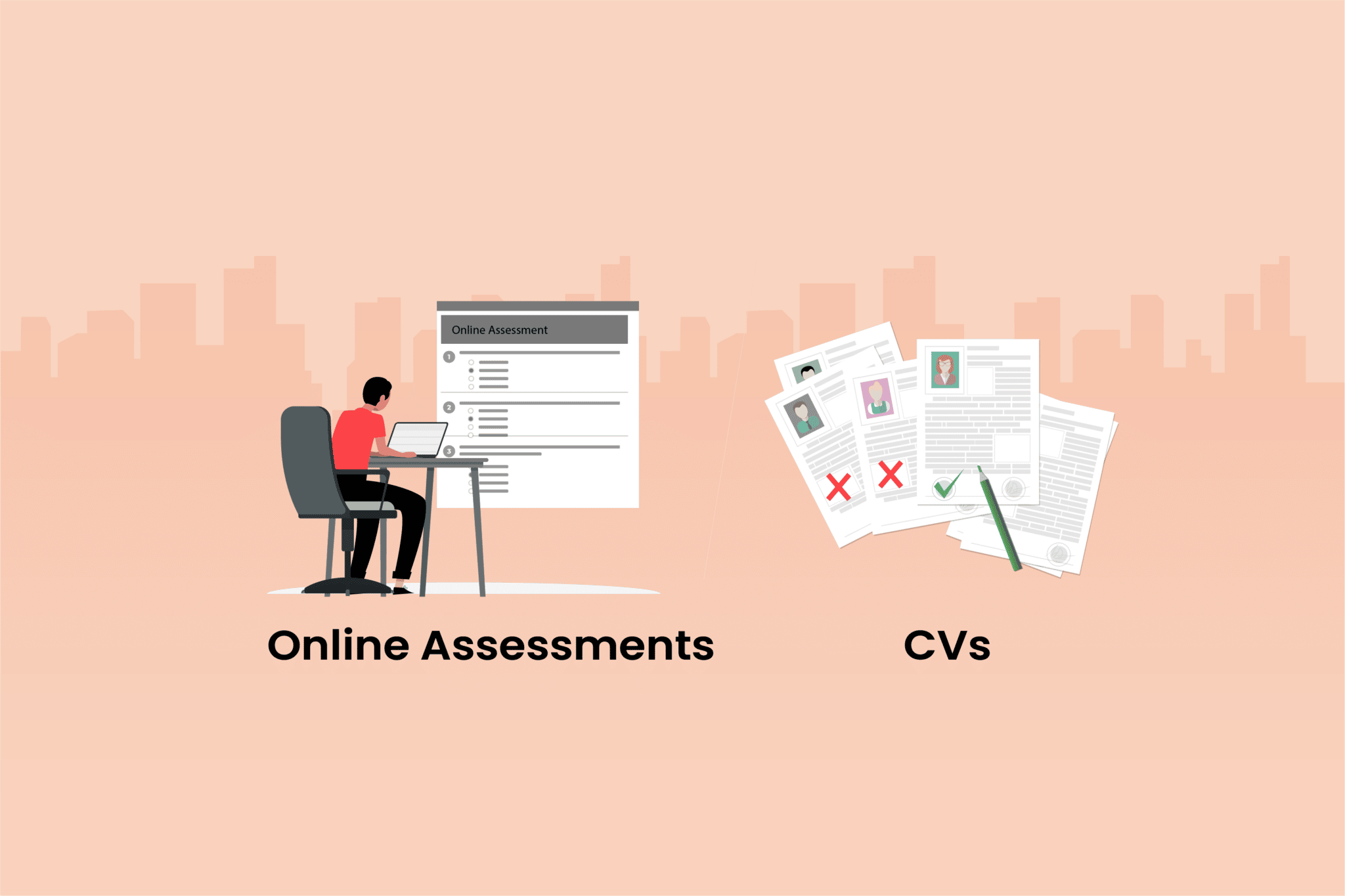In today’s competitive job market, organizations are constantly looking for ways to improve their recruitment process and attract the best candidates. One strategy that has gained popularity in recent years is the use of hiring assessments. Hiring assessments are tools that employers use to evaluate candidates’ skills, competencies, and potential fit for the job and the organization.
Research has shown that using hiring assessments can help to reduce the time and costs associated with the recruitment process. According to a study conducted by Aberdeen Group, organizations that use pre-hire assessments reduce their time-to-hire by 36% and their cost-per-hire by 39% compared to those that do not use assessments.
Using hiring assessments can bring numerous benefits to the recruitment process, including improved hiring outcomes, greater objectivity, reduced time and costs, enhanced candidate experience, building a stronger talent pipeline, and enhanced retention rates. However, implementing hiring assessments correctly is crucial to ensure that they are effective and fair.
In this blog, we will explore each of these benefits in more detail, as well as best practices for implementing hiring assessments. Whether you are a hiring manager or a job seeker, this blog will provide valuable insights into the benefits and best practices of using hiring assessments in the recruitment process.
Introduction to hiring assessments
Hiring assessments are becoming increasingly popular among organizations seeking to improve their recruitment processes. Hiring assessments are a method of evaluating a candidate’s skills, abilities, personality traits, and fit for a specific role. The use of hiring assessments is based on the belief that a candidate’s past behavior is a good predictor of their future performance.
Hiring assessments can take various forms, such as cognitive tests, personality tests, situational judgment tests, work samples, and simulations. These assessments provide objective data that can help hiring managers make more informed decisions about which candidates to hire.
Using hiring assessments in the recruitment process has many benefits for both the organization and the candidate. For the organization, hiring assessments can improve hiring outcomes, reduce time and costs associated with hiring, build a stronger talent pipeline, and enhance retention rates. For the candidate, hiring assessments can provide a fair and objective evaluation of their skills and abilities, and they can help the candidate identify areas for improvement.
However, it is important to note that hiring assessments are not foolproof and should be used in conjunction with other recruitment methods, such as interviews, reference checks, and background checks. Additionally, it is essential to use validated and reliable assessments and to ensure that the assessments used are relevant to the role being filled.
Hiring assessments are an effective tool for organizations seeking to improve their recruitment processes and make more informed hiring decisions.
Improved hiring outcomes through assessments
Hiring assessments have become increasingly popular in recent years as a tool to improve the recruitment process. These assessments are a standardized and objective way to evaluate candidates based on their skills, competencies, and personality traits. By using assessments, employers can improve the quality of hires and reduce the risk of costly bad hires.
One of the main benefits of using hiring assessments is the improved hiring outcomes that they can provide. Assessments allow employers to more accurately assess the skills and abilities of candidates, which can help identify the best fit for the position. This, in turn, can lead to better hiring outcomes, such as increased productivity, better job performance, and a reduction in turnover rates.
Assessments can also help identify candidates who may not have the specific experience or qualifications required for the job, but who have the potential to excel in the role with the right training and development. This can help employers build a stronger talent pipeline and increase diversity in their workforce by giving more opportunities to candidates who may have been overlooked in a traditional resume-based hiring process.
Additionally, hiring assessments can help reduce bias in the recruitment process. By using a standardized assessment process, employers can reduce the impact of personal biases or assumptions, resulting in a more objective evaluation of candidates. This can lead to a fairer and more equitable hiring process, which can help improve the company’s reputation and attract a more diverse pool of candidates.
The use of hiring assessments can provide numerous benefits to employers looking to improve their recruitment process. By using objective and standardized assessments, employers can make more informed hiring decisions, increase the quality of their hires, and build a stronger talent pipeline. The improved hiring outcomes that assessments provide can result in better job performance, increased productivity, and higher retention rates, ultimately leading to a more successful organization.
Objectivity in the hiring process
Objectivity in the hiring process is essential for ensuring fair and consistent evaluations of candidates. Hiring assessments can play a crucial role in achieving objectivity by providing a standardized and structured approach to evaluating candidates’ skills and qualifications.
When assessing candidates through traditional methods, such as reviewing resumes and conducting interviews, personal biases and assumptions can often come into play. For example, a hiring manager may unconsciously favor candidates who share similar backgrounds or experiences, or who exhibit certain personality traits that they personally value. This can lead to a biased evaluation of candidates and result in a less diverse workforce.
Using hiring assessments can help minimize the impact of personal biases by providing a standardized evaluation process that is based on objective criteria. By using a standardized approach, employers can ensure that all candidates are evaluated on the same criteria, regardless of their background or personal characteristics.
Furthermore, assessments can help to identify candidates’ strengths and weaknesses based on objective measures, rather than subjective opinions. This can help employers make more informed decisions about which candidates are the best fit for the job, based on their actual skills and qualifications, rather than on personal preferences.
Using hiring assessments can also help employers to be more transparent and accountable in their hiring process. By using a standardized and objective evaluation process, employers can demonstrate that their hiring decisions are based on objective criteria, rather than on personal biases or assumptions.
Using hiring assessments can help to achieve greater objectivity in the hiring process. By providing a standardized and objective evaluation process, employers can ensure that all candidates are evaluated on the same criteria, regardless of their background or personal characteristics. This can help to minimize the impact of personal biases and ensure that hiring decisions are based on objective criteria, resulting in a more diverse and inclusive workforce.
Reducing time and costs associated with hiring
Hiring the right candidate is crucial for the success of any organization, but the traditional hiring process can be time-consuming and expensive. Hiring assessments can help to reduce both the time and costs associated with recruitment by streamlining the evaluation process and ensuring that only the most qualified candidates are selected.
Firstly, assessments can help to reduce the time spent on initial screening of candidates. Traditional screening methods such as reviewing resumes and cover letters can be time-consuming and may not provide a comprehensive view of the candidate’s skills and competencies. Hiring assessments, on the other hand, can provide a more efficient and accurate way to evaluate candidates’ abilities and qualifications, helping to reduce the time spent on initial screening.
Moreover, assessments can help to identify the most qualified candidates early in the recruitment process, reducing the need for multiple rounds of interviews. This can help to save time and resources, allowing employers to focus on only the most promising candidates.
Using hiring assessments can also help to reduce the costs associated with hiring. Traditional recruitment methods, such as job postings, advertising, and recruitment agencies, can be expensive. In addition, poor hiring decisions can result in costly turnover and re-hiring expenses. By using assessments, employers can reduce the risk of making bad hires, resulting in lower turnover rates and less need for re-hiring.
Furthermore, assessments can help to identify candidates who may require less training and development, resulting in lower onboarding costs. By selecting candidates who already possess the necessary skills and competencies for the role, employers can save both time and money on training and development.
Hiring assessments can help to reduce both the time and costs associated with recruitment. By streamlining the evaluation process and ensuring that only the most qualified candidates are selected, employers can save time and resources on initial screening and multiple rounds of interviews. Additionally, assessments can help to reduce the risk of bad hires and resulting turnover costs, as well as lower onboarding costs by identifying candidates who require less training and development.
Also Read : The role of technology in skill assessments and its impact on the recruitment process.
Improved candidate experience
In today’s job market, candidates have many options, and the competition for top talent is fierce. A positive candidate experience can make all the difference in attracting and retaining high-quality candidates. Hiring assessments can help to improve the candidate experience by providing a fair and transparent evaluation process and giving candidates a better understanding of the job requirements and expectations.
Assessments can provide candidates with a clearer understanding of the job requirements, responsibilities, and expectations. This can help to ensure that candidates have a realistic understanding of the role and can make an informed decision about whether or not to pursue the opportunity. Additionally, assessments can help to identify candidates who are the best fit for the position, reducing the likelihood of mismatches between the candidate and the job.
Moreover, hiring assessments can provide candidates with a fair and transparent evaluation process. By using a standardized and objective approach, employers can demonstrate that their hiring decisions are based on objective criteria, rather than on personal biases or assumptions. This can help to build trust and credibility with candidates and ensure that they feel they have been evaluated fairly.
Assessments can also provide candidates with feedback on their performance, helping them to understand their strengths and weaknesses and providing them with insights into areas where they may need to improve. This can help candidates to develop their skills and competencies, even if they are not ultimately selected for the position.
Using hiring assessments can improve the candidate experience by providing a fair and transparent evaluation process, giving candidates a clearer understanding of the job requirements and expectations, and providing them with feedback on their performance. This can help employers to attract and retain high-quality candidates, build a positive employer brand, and ultimately improve the overall quality of their hires.
Building a stronger talent pipeline
Building a strong talent pipeline is essential for ensuring that an organization has a steady supply of qualified candidates to fill current and future job openings. Hiring assessments can play a crucial role in building a stronger talent pipeline by identifying high-potential candidates and providing insights into their skills and competencies.
Assessments can help to identify candidates who have the potential to grow and develop within the organization. By evaluating candidates on objective criteria, employers can identify candidates who possess the necessary skills and competencies for the role and have the potential to take on additional responsibilities and grow within the organization. This can help to build a strong talent pipeline of candidates who are well-suited for future job openings.
Additionally, assessments can provide employers with insights into candidates’ skills and competencies, helping to identify areas where they may need to invest in training and development. By identifying skills gaps and providing targeted training and development opportunities, employers can help to develop their existing talent pool and build a stronger talent pipeline.
Moreover, assessments can help to create a more diverse and inclusive talent pipeline. By using a standardized and objective evaluation process, employers can reduce the impact of personal biases and ensure that all candidates are evaluated on the same criteria, regardless of their background or personal characteristics. This can help to identify a more diverse pool of candidates and ensure that the organization is drawing from a broader talent pool.
Using hiring assessments can help to build a stronger talent pipeline by identifying high-potential candidates, providing insights into their skills and competencies, and creating a more diverse and inclusive talent pool. By investing in their existing talent pool and drawing from a broader range of candidates, employers can ensure that they have a steady supply of qualified candidates to fill current and future job openings.
Enhancing retention rates
Employee turnover can be costly for organizations, both in terms of time and resources. Using hiring assessments can help to enhance retention rates by ensuring that the right candidates are hired for the job and that their skills and competencies are aligned with the organization’s goals and values.
Assessments can help to identify candidates who are a good fit for the job and the organization. By evaluating candidates on objective criteria, employers can ensure that candidates possess the necessary skills and competencies for the job and that they align with the organization’s culture and values. This can help to reduce the likelihood of mismatches between the candidate and the job and improve the overall job satisfaction of employees.
Additionally, assessments can help to identify candidates who are more likely to be engaged and committed to their work. By evaluating candidates on factors such as motivation, personality, and work style, employers can identify candidates who are likely to be a good fit for the job and the organization’s culture. This can help to improve employee engagement and job satisfaction, which can lead to higher retention rates.
Moreover, assessments can help to identify areas where employees may need additional support or training. By identifying skills gaps and providing targeted training and development opportunities, employers can help to improve employee performance and job satisfaction, which can lead to higher retention rates.
Using hiring assessments can help to enhance retention rates by ensuring that the right candidates are hired for the job, that their skills and competencies are aligned with the organization’s goals and values, and that they receive the support and training they need to succeed. By investing in the success of their employees, employers can improve retention rates and reduce the costs associated with employee turnover.
Best practices for implementing hiring assessments
While using hiring assessments can bring numerous benefits to the recruitment process, it is essential to implement them correctly to ensure that they are effective and fair. Here are some best practices for implementing hiring assessments:
Identify the objectives
Before implementing hiring assessments, employers should clearly define their objectives for using them. This can help to ensure that the assessments are aligned with the organization’s goals and values.
Choose the right assessments
Employers should select assessments that are valid, reliable, and relevant to the job and the organization’s culture. It is essential to choose assessments that are appropriate for the job level and that measure the necessary competencies and skills.
Train assessors
Assessors should be trained to administer the assessments correctly and to ensure that they are being used consistently and fairly. This can help to ensure that the assessment results are reliable and valid.
Ensure fairness
It is essential to ensure that assessments are administered fairly and that all candidates are evaluated on the same criteria. This can help to reduce the impact of personal biases and ensure that all candidates have an equal opportunity to demonstrate their skills and competencies.
Provide feedback
Candidates should receive feedback on their performance in the assessments. This can help to provide candidates with insights into their strengths and weaknesses and areas where they may need to improve. Additionally, it can help to build trust and credibility with candidates and demonstrate that the assessment process is fair and transparent.
Evaluate the effectiveness
Employers should evaluate the effectiveness of the assessments regularly. This can help to ensure that they are achieving the desired outcomes and that they are being used correctly.
By following these best practices, employers can ensure that their hiring assessments are effective, fair, and aligned with their organizational goals and values. This can help to attract and retain high-quality candidates and improve the overall quality of their hires.
Introducing testlify: the ultimate pre-hiring assessment platform for recruiters
Testlify is a powerful pre-hiring assessment platform designed to simplify the process of candidate evaluation for recruiters. With its vast pre-built test library and customizable assessment options, recruiters can easily evaluate candidates’ skills and suitability for the role. Our talent assessment tool provides recruiters with the flexibility to choose from pre-built tests or create their own custom assessments tailored to the specific needs of their organization. Moreover, the talent assessment tool offers a white label feature, allowing recruiters to brand the talent assessment platform as their own, creating a seamless and professional candidate experience. Our talent assessment platform is an excellent tool for recruiters looking to streamline their hiring process and find the best-suited candidates for their organization.
Conclusion
Using hiring assessments in the recruitment process can bring numerous benefits to organizations, including improved hiring outcomes, greater objectivity, reduced time and costs, enhanced candidate experience, building a stronger talent pipeline, and enhanced retention rates. By implementing best practices for using hiring assessments, employers can ensure that they are effective, fair, and aligned with their organizational goals and values. Job seekers can also benefit from the use of hiring assessments by having a better chance of demonstrating their skills and competencies and finding a job that is a good fit for them.
If you’re interested in implementing hiring assessments in your organization or as a job seeker, Testlify is a hiring assessment platform that can help. Testlify offers a variety of assessments, including cognitive, personality, and skills tests, that are designed to measure the competencies and skills necessary for various job roles. With Testlify, you can create customized assessments, invite candidates to take the tests, and receive detailed reports on their performance.
Don’t miss out on the benefits of using pre-hiring assessments in the recruitment process. Try Testlify today to improve the quality of your hires and build a stronger talent pipeline.








